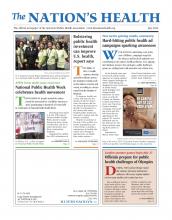The failure of the U.S. health system to develop and deliver effective preventive strategies is taking a toll on the nation’s economy and society, according to a recent report from the Institute of Medicine.
To improve health outcomes and increase the quality of life for Americans, the report calls on the federal government to double its investment in the chronically underfunded public health system and to reform how the system is funded.
Despite its position at the top of the world’s economic superpowers, the United States is hardly a superpower in health, the report said. Though it spends more on health than other nations — almost $2.5 trillion in 2009 — the United States lags behind other wealthy nations in life expectancy, infant mortality and other indicators of population health. To improve health outcomes in the United States and keep up with global peers, the U.S. should transform the way it invests in health, the report said. It also said more attention should be paid to population-based prevention efforts and that the way in which public health funding is allocated, structured and used should be remedied.
Released in April, “For the Public’s Health: Investing in a Healthier Future,” asserts that population-based prevention efforts can improve Americans’ health more efficiently and effectively than clinical care alone, yet society’s “fixation” on clinical care overshadows population-based activities.
“Our strategies in creating health in the United States haven’t been working and they have been costing an enormous amount,” said APHA member Marthe Gold, MD, MPH, chair of the committee that wrote the report. “We need to rethink how we create a healthier and more productive United States.”
The continuing focus on the medical care delivery system as the place to find all the solutions is not working, Gold said.
“Until we can turn off the flow of Americans who need to enter the medical care system by changing social and physical environmental conditions that make them unhealthy, we are just going to keep putting more and more pressure on an expensive system and create needless suffering for people,” Gold said.
The report — the third in a series examining strengthening the nation’s public health system — recommends that federal spending on public health be at least doubled, from its current level of about $11.6 billion per year to approximately $24 billion per year as a starting point to meet the needs of public health departments. To raise the additional funds, the report suggests instituting a “transaction tax” on medical care services and using the funds to improve environmental and social conditions that promote health and prevent diseases — such as obesity — that are largely outside the medical care system’s ability to influence.
“Twelve billion dollars in a $2.5 trillion dollar health spend is a little ripple in the pond,” Gold told The Nation’s Health. “We are talking about perhaps a half a percent of a transaction tax that the committee recommends to place on medical transactions.”
To guide the allocation of the public health dollars, the report calls for the National Prevention, Health Promotion and Public Health Council to oversee the development of a minimum package of public health services and programs that every community should receive from state and local health departments. Presently, there are no standards for public health services that should be available in every community and there is little or no dedicated funding to support basic public health capabilities needed for all or most programs, the report said.
“There is no ability to provide a uniform set of services because the people who are providing the funding have not agreed what that is, and have not provided the financing for it,” said David Fleming, MD, director and health officer for public health in Seattle and King County, Wash. “One of the ways forward is to first try to reform our funding streams to make them still full of accountability but more flexible, so that dollars can be used how they are best needed.”
In addition to endorsing the need for a minimum package of public health services, the report recommends that federal departments and agencies that fund state and local public health departments take steps to facilitate a more flexible and efficient use of resources.
The lack of flexibility has created a funding dysfunction in the public health system that stifles productivity and innovation, APHA Executive Director Georges Benjamin, MD, FACP, FACEP (E), said in an April 19 Health Affairs blog post.
“Most public health funding originates from a complex set of specific, targeted and inadequate appropriations which over time have created funding silos with little flexibility to adapt to changing conditions,” Benjamin wrote.
At the state and local levels, public health budgets have been cut at drastic rates in recent years, according to a March 2012 report from Trust for America’s Health.
According to the analysis, 40 states cut their public health budgets from 2009 to 2010 and 2010 to 2011. Of those, 30 states trimmed their budgets for a second year in a row and 15 trimmed them for the third year in a row, according to “Investing in America’s Health: A State-By-State Look at Public Health Funding and Key Health Facts.”
In 2010–2011, the Trust for America’s Health report found, the median state funding for public health was $30.09 per capita, ranging from a high of $154.80 in Hawaii to a low of $3.45 in Nevada. From 2008 to 2011, the median per capita state public health spending decreased from $33.71 to $30.09, according to the report.
For the IOM report, “For the Public’s Health: Investing in a Healthier Future,” visit www.iom.edu.
- Copyright The Nation’s Health, American Public Health Association












